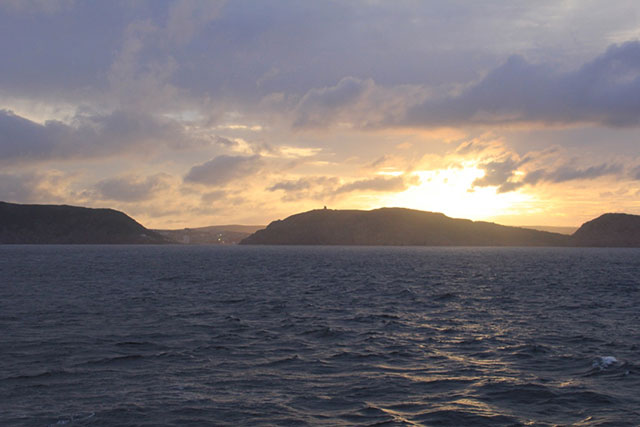
Honest, paywall-free news is rare. Please support our boldly independent journalism with a donation of any size.
On November 30, 2016, a case will come before the Canadian Supreme Court that will have momentous and potentially global implications. In April 2016 the Canadian Supreme Court, which hears only 5 percent of referred cases, agreed to judge an appeal brought by the Inuit community of Clyde River, Nunavut, against a five-year plan to carry out seismic blasting in Baffin Bay. The people who live in Clyde River, situated on Baffin Island, use the waters and ice of the Bay for hunting, a central component of their culture and primary source of food.
With Greenpeace helping to cover legal costs, this is the first time the Supreme Court has ever taken up a case from the autonomous Inuit territory of Nunavut in the 17 years since it split from the Northwest Territories. To bolster the legal campaign by amplifying the voices of Inuit activists and to respond to Inuit requests for alternatives to fossil fuels, Greenpeace sailed their ship Arctic Sunrise to the Arctic in August. At the formal invitation of the Hamlet Council, Greenpeace activists — including British actor Emma Thompson — were allowed to sail the Arctic Sunrise to deliver solar panels to Clyde River in response to the community’s stated desire for alternatives to fossil fuel-driven development and the expense and pollution of diesel. For as Inuit campaigner, Nobel Prize Nominee and author Sheila Watt-Cloutier has legitimately asked in her book The Right to be Cold:
With the sea ice and permafrost of the Arctic rapidly melting, these mining operations are becoming more and more feasible and potentially profitable…. It’s understandable, given the poverty, lack of food security and increasing difficulty of maintaining our traditional hunting culture, that the lure of resource-related jobs would be so great … [But] all over the world, Indigenous peoples have suffered the devastating effects of these industries on their lands…. Given the wealth of evidence about the dangers of the extraction industries, we Inuit should be asking ourselves, “Why would it be any different for us? How will this industry, which is so counter to our own culture of stewardship of the land, be any different in the Arctic than it has been in other parts of the world?”
The Greenpeace vessel — with current mayor of Clyde River, James Qillaq, former mayor Jerry Natanine and his daughter Clara aboard to help document changes to sea ice, observe wildlife and inform the other activists on board of the key issues — set sail from St. Johns, Newfoundland, on the evening of August 4. At the invitation of Greenpeace I was onboard the Sunrise to document and report on the trip.
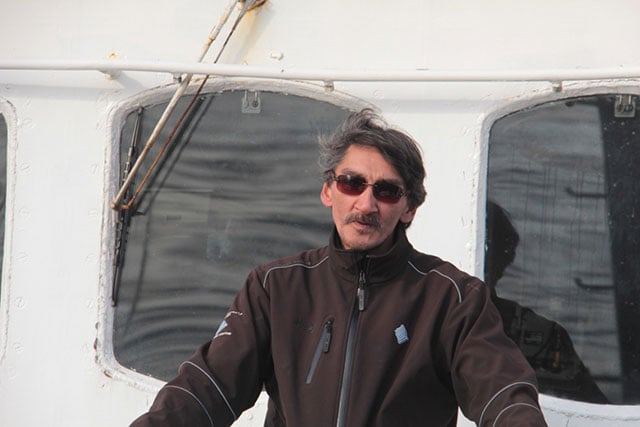 Former Mayor of Clyde River, Jerry Natanine surveys the North Atlantic Ocean from the deck of the Arctic Sunrise. (Photo: Chris Williams)
Former Mayor of Clyde River, Jerry Natanine surveys the North Atlantic Ocean from the deck of the Arctic Sunrise. (Photo: Chris Williams)
As we slowly emerged out of the protective harbor, long, slow swells set the ship rolling; the rounded hull is designed to rise up over thick ice, using the ship’s mass to drop down and crack open safe passage. However, there’s a drawback: the Arctic Sunrise is notoriously prone to pitching and lurching her way through even moderate seas.
Astern, the sun set over Newfoundland as we left one of the first European colonial settlements in North America, the port of St. Johns, named after John Cabot who sailed into the bay in 1497 on the feast day of Saint John the Baptist. Redolent with that imperial history, staring silently out to sea silhouetted atop the dark bulk of Signal Hill was Cabot’s Tower, built in 1898 to commemorate the 400th anniversary of his fateful landing on the island.
The clouds were a luminescent series of glowing oranges, reds and purples as the sun sank below the receding promontory, turning the heaving ocean crimson. With each turn of the propeller, the jaws of the bay narrowed behind us. Over the bow, the horizon stretched into curved infinity. In the distance, blowholes spewed water from the heads of giant underwater mammals.
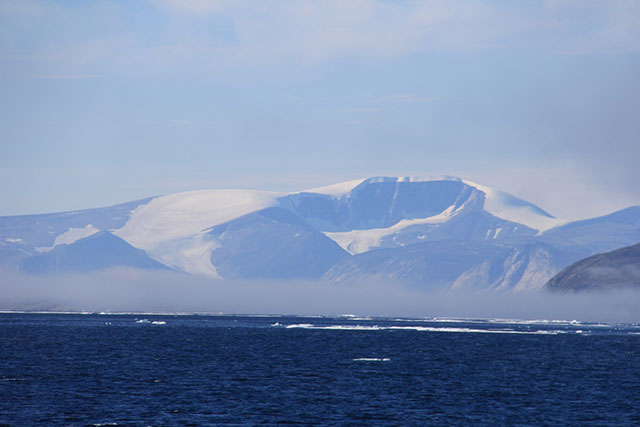 The bay to enter Clyde River is ringed by imposing, glacier-capped mountains. (Photo: Chris Williams)
The bay to enter Clyde River is ringed by imposing, glacier-capped mountains. (Photo: Chris Williams)
Our first whale sightings electrified the ship’s complement of activists and crew. The life of whales is part of the reason we were heading far above the Arctic Circle to Clyde River. With a surface area comparable to Western Europe, the 37,000 Inuit living in communities across Nunavut share the high Arctic with several species of whale, as well as narwhals, walruses, seals, polar bears, caribou, fish and birds, all of which the Inuit hunt, eat or otherwise use.
Situated between Baffin Island and the southwest coast of Greenland, Baffin Bay is a sensitive ecosystem with an unusually high number of different species of Arctic marine mammals. Until the last century, the only humans to regularly cross through the area were Inuit communities, who have traversed and lived in the region for 4,000 years. Now, however, the area and its Indigenous inhabitants are facing the threat of seismic blasting to survey for oil and gas deposits.
New Threats From Seismic Blasting
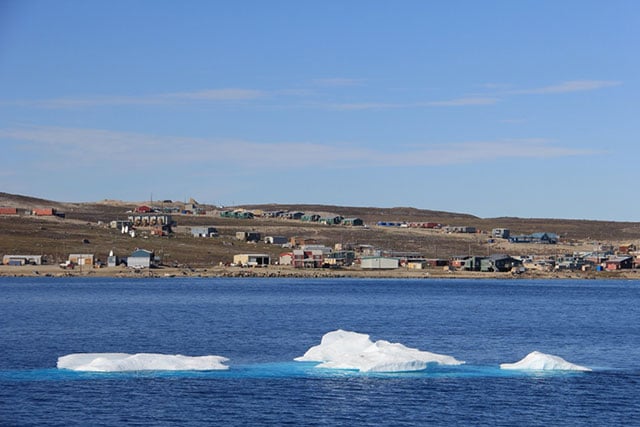 In the hamlet of 1,100 people nestled below the mountains in Clyde River, residents have been fighting seismic blasting in their hunting grounds of Baffin Bay. (Photo: Chris Williams)
In the hamlet of 1,100 people nestled below the mountains in Clyde River, residents have been fighting seismic blasting in their hunting grounds of Baffin Bay. (Photo: Chris Williams)
For former mayor Natanine (and his generation), the decision to oppose drilling for oil and gas was something he initially did not consider until he spoke with Elders about the consequences of seismic testing carried out in the 1970s:
Our community here of Clyde River experienced seismic blasting in our area. My father’s generation and his brothers were the ones who experienced and saw firsthand what it did to seals. When they were hunting seals, because [the seals] were deaf they could almost go right up to the seals and puss was coming out of [their ears]. At one point I was talking to my father, talking to my uncles trying to figure out what’s going to happen with seismic blasting … because I was in support of it, thinking it’s going to bring all the resources and we’ll be able to build our infrastructure from it.
It took those conversations and the experience of the older generation to start Natanine on the journey to activism and opposition to testing and oil drilling:
My father and my uncle, they both said, “You know we have to stop this, we have to do everything we can to stop this because of the impacts it’s going to have on seals.” Seals are the mainstay, everyday food and that really got to me because as a new generation after them my dream was fancy lights and casinos and whatever. They changed my heart and I started researching what seismic testing is, what it does and how it affects everything around it. It’s a destruction machine, that’s what it is; it’s a destruction machine. They want to destroy, get the animals moved away so that the humans will move away and not be in their way to drill for oil.
Mounted on a specialized ship, seismic blasting (or “seismic testing,” as the industry calls the practice) uses underwater air guns to send high power air blasts through the water and into the subsurface rock. When the signal bounces back to an array of detectors trailing six to 10 kilometers behind the survey ship, geologists analyze it to detect differences in density that would indicate the location of a potential oil or gas deposit. “Testing” is a prelude to drilling. According to a survey carried out by the US Geological Survey (USGS) in 2008, the Arctic as a whole contains a substantial amount of oil and gas: 13 percent of the world’s undiscovered oil, 30 percent of undiscovered gas and 20 percent of undiscovered natural gas liquids, with significant deposits, as well as minerals, in and around the Inuit territory of Nunavut (see the Greenpeace-commissioned Center for Sustainable Economy’s “Beyond Fossil Fuels” report for details).
Despite growing resistance to drilling in the Canadian Arctic and elsewhere across the world, the current low price of oil and other technical constraints, Brad Hayes, president of geoscience consulting firm Petrel Robertson is confident that energy companies will make progress in the far north because reserves “are simply of too high a quality to be ignored…. They’re not low-cost places to get at, because of their remoteness and what you need to do to plug in facilities, but once you have facilities and pipelines and so on, then you have an enormous resource of very high-quality oil and gas.”
The Canadian Government and Fossil Fuel Exploitation
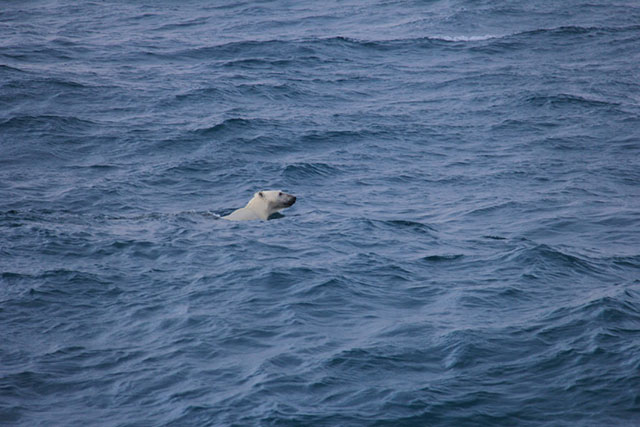 A polar bear swims off Baffin Island, heading for land. A species threatened from multiple directions as the ice melts and with the potential for seismic blasting to drive away its marine prey. (Photo: Chris Williams)
A polar bear swims off Baffin Island, heading for land. A species threatened from multiple directions as the ice melts and with the potential for seismic blasting to drive away its marine prey. (Photo: Chris Williams)
No real consultation took place to find out what residents of Clyde River thought about the proposed blasting. There was a meeting in 2014 before the National Energy Board’s approval that was open to the public, but according to Dr. Shari Gearheard, a climate scientist and researcher for the National Snow and Ice Data Center who has been living in Clyde River for the last 16 years, the message was, “We’re here to tell you what’s going to happen.”
The slide presentation was not in Inuktitut, drawings were not to scale and according to Natanine, any questions raised about the plan were summarily dismissed. When asked about potential impacts on marine life, company representatives were unable to provide answers. Despite oil industry assertions that seismic blasting is safe for underwater life, it’s hard to square with the common-sense idea that animals that depend on sound for every aspect of their life activities could remain unaffected by high-volume sound inundating their domain every 10 seconds for months on end, with decibel levels comparable to .5 kilos of exploding TNT. Michael Stocker, director of the nonprofit advocacy group Ocean Conservation Research in Lagunitas, California, notes, “Most animals in the ocean use sound the way animals on land use eyesight…. And when we talk about saturating their environment with noise, it’s going to have some impact, regardless of whether we know what that impact is.”
The National Energy Board says it plans to have one person spot whales from the bridge of the seismic vessel and call off blasting if a mammal is spotted within 500 meters. However, Stocker says, “Having somebody sitting on a watch stand looking for whales at 1,000 meters is a token gesture that’s fairly meaningless.” I would have to agree: Aside from the fact that whales spend most of their time underwater, having now spent many hours unsuccessfully looking for whales in the Arctic through often dense and shifting fog that regularly limits visibility to a few meters, it’s hard to imagine such a system being effective even during periods of high visibility.
A day’s travel north by ship from Clyde River is the other-worldly stunning beauty of Sam Ford Fiord, where cliffs soar a vertical mile above the opal blue waters and we see abundant narwhals. Ninety percent of the global population of narwhals is found in the Canadian Arctic and Baffin Bay. One of only two surviving species of toothed whales in the Monodontidae family and highly specialized Arctic predators, these astonishingly odd-looking marine mammals sport a single giant tusk and are a staple of Inuit diet. The narwhals are thought to be particularly sensitive to noise.
In a NOAA study carried out in 2004, US government scientists found the dominant signal reaching sound detectors placed near the Mid-Atlantic Ridge on the floor of the Atlantic was from air guns operated 3,000 km away, off the coast of Nova Scotia, western Africa and northeast of Brazil.
Even the since-renamed Minerals Management Service, the corrupt US government agency that mismanaged the calamitous Deepwater Horizon oil spill of 2010 and failed to adequately regulate oil drilling in the Gulf of Mexico, registered “potentially adverse” impacts on sea life. As documented in a Greenpeace-commissioned report on seismic testing by Dr. Oliver Boisseau, a senior research scientist for Marine Conservation Research,”It is clear that noise from seismic activity has an impact on whales as it can damage their hearing, ability to communicate and also displace animals, affecting diving behavior, feeding and migration patterns. There are increasing indications that this could cause serious injury, and may also disrupt reproductive success and increase the risk of strandings and ice entrapments.”
The Legal Fight to Stop Blasting
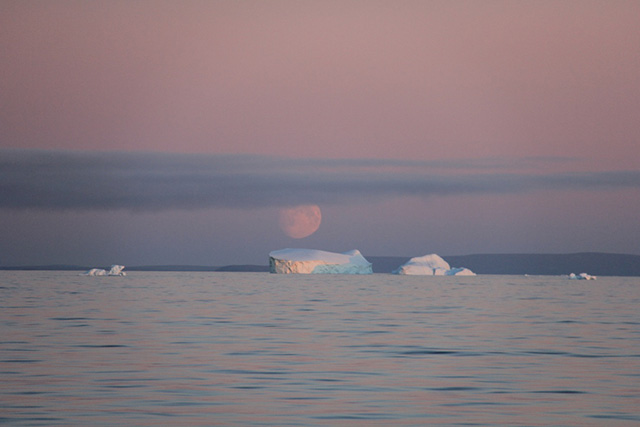 The moon rises in silent majesty over Clyde River, floating bergs drifting by. The dangers of oil and gas drilling in such a remote and sublimely beautiful place cannot be over-estimated. (Photo: Chris Williams)
The moon rises in silent majesty over Clyde River, floating bergs drifting by. The dangers of oil and gas drilling in such a remote and sublimely beautiful place cannot be over-estimated. (Photo: Chris Williams)
Knowledgeable and determined, Natanine has been tirelessly leading the legal fight against the blasting, explaining to other Inuit the dangers to their hunting grounds and the food they rely on to feed themselves. Organized by Natanine and others, Clyde River took its challenge to the National Energy Board’s decision to grant blasting permission against the wishes of the community to the Canadian court of appeal. The judge, Justice Eleanor Dawson ruled against Clyde River in August 2015, writing that consultation had been adequate and whether the community agreed with the National Energy Board decision or not was irrelevant. Undeterred, Natanine pledged to keep fighting. “We are going to appeal the decision to the Supreme Court of Canada,” he said, and that is exactly where the case is now headed on November 30.
With the ongoing legal issues, seismic blasting has been successfully postponed three times. In the intervening two years, a lot has changed in the political and legal landscape of Canada, and some Inuits’ understandably intense distrust and outright hatred for Greenpeace — dating back to the organization’s anti-sealing campaigns of the late 1970s that devastated the Inuit economy — has also shifted. Greenpeace issued an apology for past mistakes and the negative impact they had on Inuit livelihoods that was printed in Inuit media in 2014 and vowed a very different approach. Natanine was eventually convinced to give the organization another chance to help, not harm, Inuit. As Natanine explains it: “At first, I thought, I hate those fuckers…. But, you know, they’re just human. They didn’t know what they were doing. And now, to acknowledge they were wrong and that they had this negative impact on us, it touched me inside. I thought I would just forever hate them.”
Renewable Energy and the Arctic
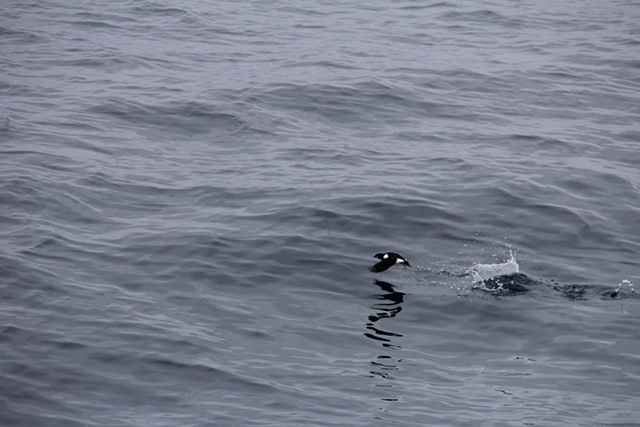 Seismic blasting won’t just affect marine life and Inuit, but the habits and modes of life of all creatures in contact with the sea. Here a Dovekie takes off from the Arctic Ocean. (Photo: Chris Williams)
Seismic blasting won’t just affect marine life and Inuit, but the habits and modes of life of all creatures in contact with the sea. Here a Dovekie takes off from the Arctic Ocean. (Photo: Chris Williams)
In their joint statement on the Arctic released in March, Canadian Prime Minister Justin Trudeau and US President Barack Obama write about how they will act “with partners” to implement “innovative renewable energy and efficiency alternatives to diesel and advance community climate change adaptation.” They add, “We will do this through closer coordination among Indigenous, state, provincial, and territorial governments and the development of innovative options for housing and infrastructure.”
Yet it took Greenpeace, at the request of the Clyde River Hamlet Council, to bring solar power to Clyde River to help them offset their use of diesel. Nunavut’s government spends 20 percent of its annual budget on energy, primarily diesel for electricity production, heating and transportation. Electricity and heating cost more in Nunavut than anywhere else in Canada, which helps to explain why the government of Nunavut recently voted to change the law to promote renewable energy production through net metering. In recognition of this and the desire to retain their culture while utilizing 21st century technology to reject fossil fuel-based development, Inuit in Clyde River now have a partially solar-powered community hall.
While solar cannot be a complete answer to electricity generation in the Arctic, it will help offset the financial, environmental and health costs of diesel and can begin to chart a different developmental pathway. If solar panels can be successfully installed and maintained in a remote community in the far northern reaches of land on the planet, it naturally raises the question: What’s stopping so many other communities from using the wind and sun for power generation?
Echoing Watt-Cloutier, Natanine said that the real question facilitated by the production of renewable energy is about self-determination and social power — not electrical power:
These companies are not in it to help us to gain that [independence] and we know that from experience and looking at other parts of the world. Oil and gas is not a good answer for us to gain independence, and as Inuit we want to get back to independence where we don’t have to depend on anyone: that’s what we have to work for. Get away from fossil fuels where the companies and governments will control us, to a point where we can have our own power. Maybe through solar power and through wind power or other renewable resources, and that’s where we want to get to. We want to be able to control our own lives again.
Of course, if Canada were serious about genuinely addressing the issues of poverty, racism, lack of infrastructure, health issues, inequality and the impact of decades of neocolonial government policies for the 37,000 Inuit, it would be very easy. Given the hundreds of billions of dollars made through tar sands extraction and mining by Canadian companies around the world and with such a low population, it would be entirely possible to eradicate poverty in the whole of Nunavut. From data compiled by Idle No More, in which reparations for historical crimes and land theft is taken into account, the Canadian government is in debt to Indigenous peoples to the tune of trillions of dollars.
After years of struggle and three years of postponement of seismic blasting, the people of Clyde River will have their day in court in Ottawa on November 30. A location to write into the calendars of anyone concerned with Inuit justice as the place to be. A second case based on similar arguments is being brought by the Chippewa of the Thames First Nation and will also be heard by the Supreme Court on November 30. The Chippewas are fighting against the National Energy Board-approved decision to back Enbridge’s expansion and reversal of its 830 km oil pipeline Line 9B, built in 1975, that runs from Sarnia, Ontario to Montreal, Quebec across their land.
Whichever way those decisions turn, they will reverberate across the whole of Canada. Furthermore, the Canadian Supreme Court is cited more than any other as precedent by courts around the world. Therefore, the decision holds implications for Indigenous peoples across the globe fighting to control their land and resist the further expansion of fossil fuel production. Further bolstering the Inuit legal case, on May 10 the Canadian government reversed its earlier stance and officially signed UNDRIP (United Nations Declaration on the Rights of Indigenous Peoples).
Whether they live up to that commitment will depend on how much pressure can be brought to bear on the National Energy Board, the Canadian government and Prime Minister Trudeau to live up to their climate change rhetoric and documented support of Indigenous rights. We will find out whether British Columbia Grand Chief Edward John was speaking in good faith when, in response to the signing of UNDRIP he commented, “Indigenous governments are not some inferior form of authority…. They are the original form of authority over their lands, resources and territories.”
For more on this topic, please read the first article in this series, “On Melting Ice: Inuit Struggle Against Oil and Gas in the Arctic.”
Media that fights fascism
Truthout is funded almost entirely by readers — that’s why we can speak truth to power and cut against the mainstream narrative. But independent journalists at Truthout face mounting political repression under Trump.
We rely on your support to survive McCarthyist censorship. Please make a tax-deductible one-time or monthly donation.